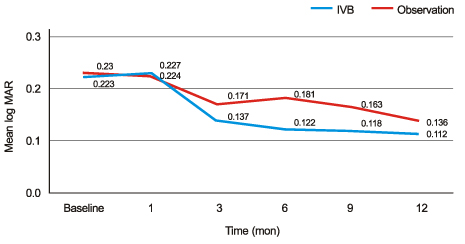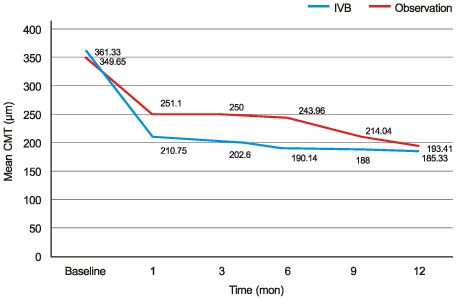J Korean Ophthalmol Soc.
2012 Jun;53(6):781-785.
The Efficacy of Intravitreal Bevacizumab Injection in Patients with Acute Central Serous Chorioretinopathy
- Affiliations
-
- 1Myung-Gok Eye Research Institute, Department of Ophthalmology, Konyang University Kim's Eye Hospital, Seoul, Korea. moon17272@kimeye.com
Abstract
- PURPOSE
To evaluate the efficacy of intravitreal bevacizumab injection (IVB) in acute central serous chorioretinopathy.
METHODS
Retrospective chart review of 87 eyes of 80 patients. They received intravitreal bevacizumab injection (n = 40) and observed without any treatment or any medication (n = 47) for initial treatment of acute CSC. Patient demographics and best-corrected visual acuity (BCVA), central macular thickness (CMT) at baseline were analyzed. Then we had regular follow-ups of BCVA and CMT.
RESULTS
All patients showed improvement in visual acuity and resolution of subretinal fluid following treatment. In the bevacizumab-treated group, the mean BCVA improved from 0.22 +/- to 0.11, mean CMT fell from 361.33 to 185.33 (microm) and recurrence rate was 47%. The conservative-treated group showed an improvement in BCVA from 0.23 at baseline to 0.14, mean CMT fell from 349.65 to 193.41 (microm) and recurrence rate was 70% (p = 0.130, p = 0.908 and p = 0.030, respectively). However, the change of BCVA and CMT of 2 groups showed no differences at any follow-up visit. Recurrence rate was significantly low in bevacizumab-treated group.
CONCLUSIONS
The bevacizumab-treated group had relatively low rates of recurrence in acute CSC patients compared to the observation group. However, intravitreal bevacizumab showed no positive effect in BCVA and CMT of acute CSC patients compared to the observation group. Further investigation will be helpful to understand this therapy in patients with CSC.
Keyword
MeSH Terms
Figure
Reference
-
1. Klais CM, Ober MD, Ciardella AP, et al. Ryan SJ, Schachat AP, editors. Cenral serous chorioretinopathy. Retina. 2006. Vol. 2:4th ed. Philadelphia: Mosby;1135–1162.2. Marmor MF. New hypotheses on the pathogenesis and treatment of serous retinal detachment. Graefes Arch Clin Exp Ophthalmol. 1988. 226:548–552.3. Spitznas M. Pathogenesis of central serous retinopathy: a new working hypothesis. Graefes Arch Clin Exp Ophthalmol. 1986. 224:321–324.4. Costa RA, Farah ME, Freymüller E, et al. Choriocapillaris photodynamic therapy using indocyanine green. Am J Ophthalmol. 2001. 132:557–565.5. Costa RA, Scapucin L, Moraes NS, et al. Indocyanine green-mediated photothrombosis as a new technique of treatment for persistent central serous chorioretinopathy. Curr Eye Res. 2002. 25:287–297.6. Stanga PE, Lim JI, Hamilton P. Indocyanine green angiography in chorioretinal diseases: indications and interpretation: an evidence-based update. Ophthalmology. 2003. 110:15–21.7. Piccolino FC, Borgia L. Central serous chorioretinopathy and indocyanine green angiography. Retina. 1994. 14:231–242.8. Lim JW, Kim MU. The efficacy of intravitreal bevacizumab for idiopathic central serous chorioretinopathy. Graefes Arch Clin Exp Ophthalmol. 2011. 249:969–974.9. Ficker L, Vafidis G, While A, Leaver P. Long-term follow-up of a prospective trial of argon laser photocoagulation in the treatment of central serous retinopathy. Br J Ophthalmol. 1988. 72:829–834.10. Yap EY, Robertson DM. The long-term outcome of central serous chorioretinopathy. Arch Ophthalmol. 1996. 114:689–692.11. Loo RH, Scott IU, Flynn HW Jr, et al. Factors associated with reduced visual acuity during long-term follow-up patients with idiopathic central serous chorioretinopathy. Retina. 2002. 22:19–24.12. Zhao MW, Zhou P, Xiao HX, et al. Photodynamic therapy for acute central serous chorioretinopathy: the safe effective lowest dose of verteporfin. Retina. 2009. 29:1155–1161.13. Caccavale A, Romanazzi F, Imparato M, et al. Low-dose aspirin as treatment for central serous chorioretinopathy. Clin Ophthalmol. 2010. 4:899–903.14. Schaal KB, Hoeh AE, Scheuerle A, et al. Intravitreal bevacizumab for treatment of chronic central serous chorioretinopathy. Eur J Ophthalmol. 2009. 19:613–617.15. Artunay O, Yuzbasioglu E, Rasier R, et al. Intravitreal bevacizumab in treatment of idiopathic persistent central serous chorioretinopathy: a prospective, controlled clinical study. Curr Eye Res. 2010. 35:91–98.16. Seong HK, Bae JH, Kim ES, et al. Intravitreal bevacizumab to treat acute central serous chorioretinopathy: short-term effect. Ophthalmologica. 2009. 223:343–347.17. Torres-Soriano ME, García-Aguirre G, Kon-Jara V, et al. A pilot study of intravitreal bevacizumab for the treatment of central serous chorioretinopathy (case report). Graefes Arch Clin Exp Ophthalmol. 2008. 246:1235–1239.18. Lim SJ, Roh MI, Kwon OW. Intravitreal bevacizumab injection for central serous chorioretinopathy. Retina. 2010. 30:100–106.19. Spaide RF, Campeas L, Haas A. Central serous chorioretinopathy in younger and older adults. Ophthalmology. 1996. 103:2070–2080.20. Bennett G. Central serous retinopathy. Br J Ophthalmol. 1955. 39:605–618.21. Klatt C, Saeger M, Oppermann T, et al. Selective retina therapy for acute central serous chorioretinopathy. Br J Ophthalmol. 2011. 95:83–88.22. Gass JD. Pathogenesis of disciform detachment of the neuroepithelium. Am J Ophthalmol. 1967. 63:Suppl. S1–S139.23. Fok AC, Cahn PP, Lam DS, Lai TY. Risk factors for recurrence of serous macular detachment in untreated patients with central serous chorioretinopathy. Ophthalmic Res. 2011. 46:160–163.24. Schaal KB, Hoeh AE, Scheuerle A, et al. Intravitreal bevacizumab for treatment of chronic central serous chorioretinopathy. Eur J Ophthalmol. 2009. 19:613–617.25. Lee JY, Chae JB, Yang SJ, Yoon YH. Intravitreal bevacizumab versus the conventional protocol of photodynamic therapy for treatment of chronic central serous chorioretinopathy. Acta Ophthalmol. 2011. 89:e293–e294.
- Full Text Links
- Actions
-
Cited
- CITED
-
- Close
- Share
- Similar articles
-
- Comparison of Intravitreal Bevacizumab and Aflibercept Injections for Central Serous Chorioretinopathy
- The Short-term Effect of Intravitreal Bevacizumab for Treatment of Central Serous Chorioretinopathy
- Factors Influencing the Effect of the Intravitreal Bevacizumab Injection in Patients with Central Serous Chorioretinopathy
- Comparison between Focal Laser Photocoagulation and Intravitreal Bevacizumab Injection for Treating Chronic Central Serous Chorioretinopathy
- A Case of Central Serous Chorioretinopathy Associated With Retinal Detachment Improved by Intravitreal Bevacizumab Injection



